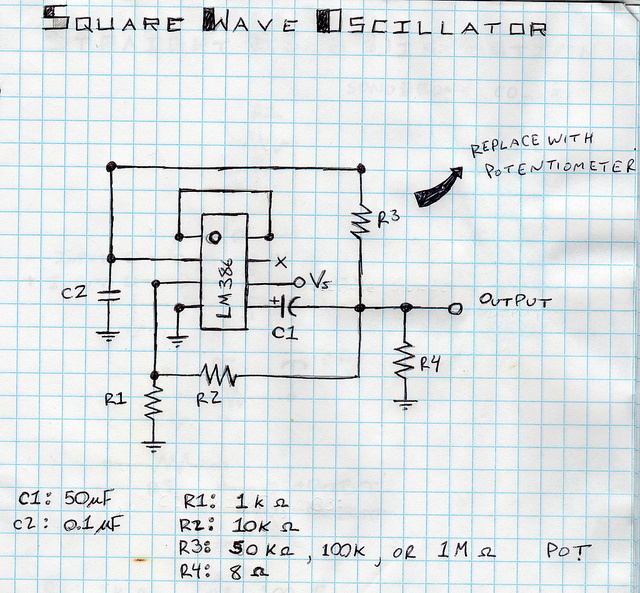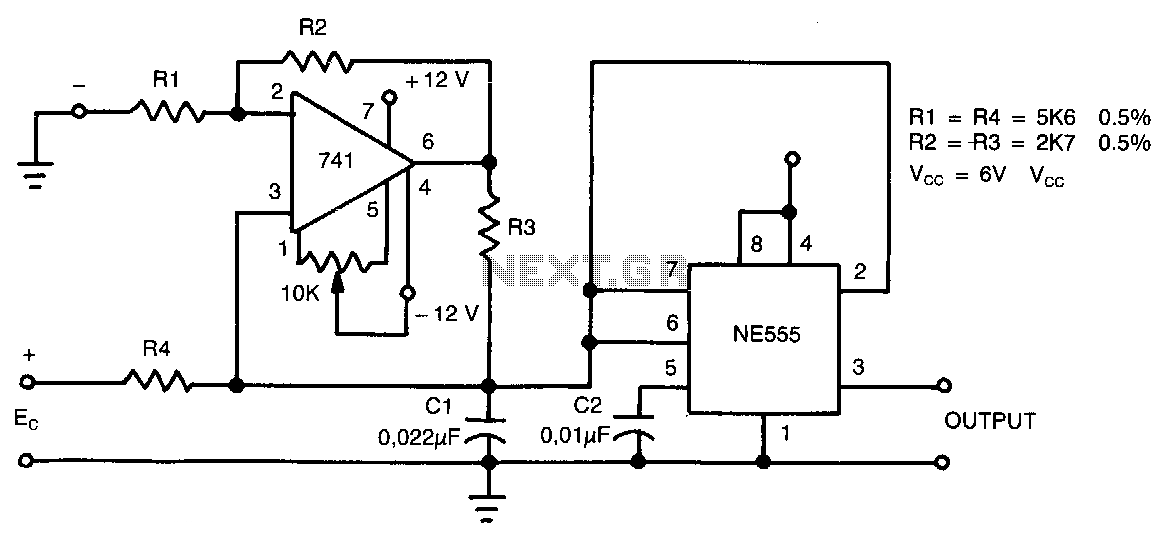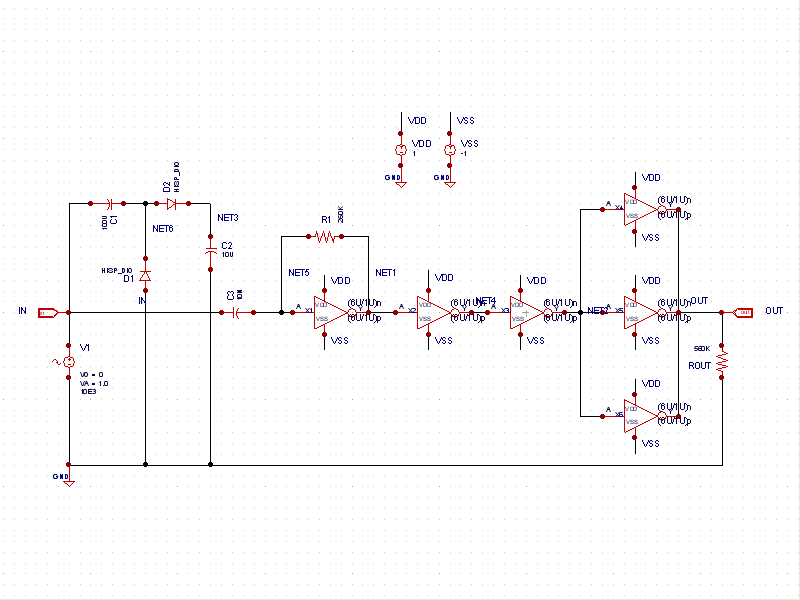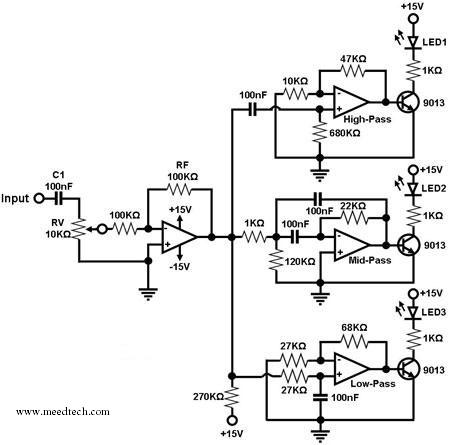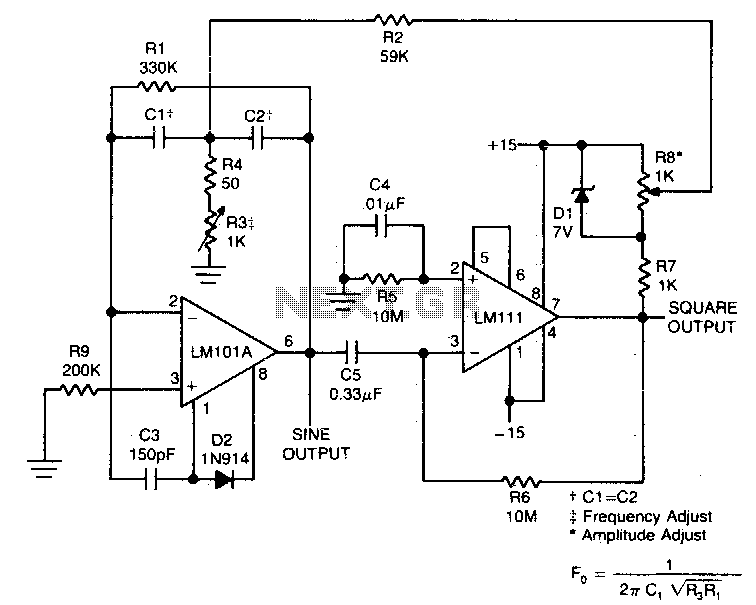
Square wave-to-triangle converter
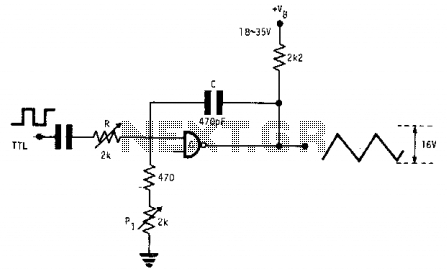
This fixed-frequency triangular waveform generator, driven by a TTL square wave, produces triangular waveforms with a peak-to-peak voltage of typically 16 V at frequencies reaching several MHz. The design utilizes a single AND open collector gate or an open collector inverter functioning as a fast integrator with gain. Precise successive adjustments of resistor R and potentiometer PI are essential. Once the correct adjustments are made, the output amplitude and linearity remain largely unaffected by the value of VB, which can range from a minimum of 18 V to a maximum of 35 V. The capacitor value indicated is suitable for operation at 100 kHz; for higher frequencies, it must be reduced proportionally.
The triangular waveform generator operates on a principle that combines digital and analog techniques to create a stable and precise output. The input TTL square wave serves as the timing reference, allowing the circuit to produce a triangular waveform at a fixed frequency determined by the timing components. The use of an open collector gate or inverter facilitates fast switching and integration, which is crucial for generating the desired waveform shape.
The integration process involves charging and discharging the capacitor through the resistor R, where the time constants are adjusted to achieve the correct slope of the triangular waveform. The gain provided by the open collector device enhances the output signal, ensuring that it reaches the desired amplitude. The adjustments of R and PI are critical, as they directly influence the frequency response and linearity of the output waveform.
The output characteristics are notably robust, as the amplitude and linearity remain stable across a range of supply voltages (VB). This flexibility allows the circuit to be utilized in various applications without significant recalibration, making it suitable for environments where voltage supply may vary.
In practice, when designing this circuit, careful attention must be paid to the choice of components, especially the capacitor value, which is crucial for maintaining the integrity of the waveform at higher frequencies. As the frequency increases, the capacitor's capacitance must be reduced to maintain the correct timing characteristics, ensuring that the triangular waveform remains sharp and well-defined.
Overall, this fixed-frequency triangular waveform generator is an effective solution for applications requiring precise waveform generation, with the ability to adapt to different operating conditions while maintaining performance integrity.This fixed frequency triangular waveform generator driven by a TTL square wave generates typically 16-V p-p triangles at frequencies up to several MHz. It uses only one AND open collector gate, or one open collector inverter as a fast integrator with gain.
Careful successive adjustments of R and PI are needed. When correct adjustments are reached, output amplitude and linearity are largely independent of the value of VB, from a minimum of 18 V up to 35 V. The value of C shown is for 100 kHz; at higher frequencies, it must be reduced in proportion. 🔗 External reference
The triangular waveform generator operates on a principle that combines digital and analog techniques to create a stable and precise output. The input TTL square wave serves as the timing reference, allowing the circuit to produce a triangular waveform at a fixed frequency determined by the timing components. The use of an open collector gate or inverter facilitates fast switching and integration, which is crucial for generating the desired waveform shape.
The integration process involves charging and discharging the capacitor through the resistor R, where the time constants are adjusted to achieve the correct slope of the triangular waveform. The gain provided by the open collector device enhances the output signal, ensuring that it reaches the desired amplitude. The adjustments of R and PI are critical, as they directly influence the frequency response and linearity of the output waveform.
The output characteristics are notably robust, as the amplitude and linearity remain stable across a range of supply voltages (VB). This flexibility allows the circuit to be utilized in various applications without significant recalibration, making it suitable for environments where voltage supply may vary.
In practice, when designing this circuit, careful attention must be paid to the choice of components, especially the capacitor value, which is crucial for maintaining the integrity of the waveform at higher frequencies. As the frequency increases, the capacitor's capacitance must be reduced to maintain the correct timing characteristics, ensuring that the triangular waveform remains sharp and well-defined.
Overall, this fixed-frequency triangular waveform generator is an effective solution for applications requiring precise waveform generation, with the ability to adapt to different operating conditions while maintaining performance integrity.This fixed frequency triangular waveform generator driven by a TTL square wave generates typically 16-V p-p triangles at frequencies up to several MHz. It uses only one AND open collector gate, or one open collector inverter as a fast integrator with gain.
Careful successive adjustments of R and PI are needed. When correct adjustments are reached, output amplitude and linearity are largely independent of the value of VB, from a minimum of 18 V up to 35 V. The value of C shown is for 100 kHz; at higher frequencies, it must be reduced in proportion. 🔗 External reference
